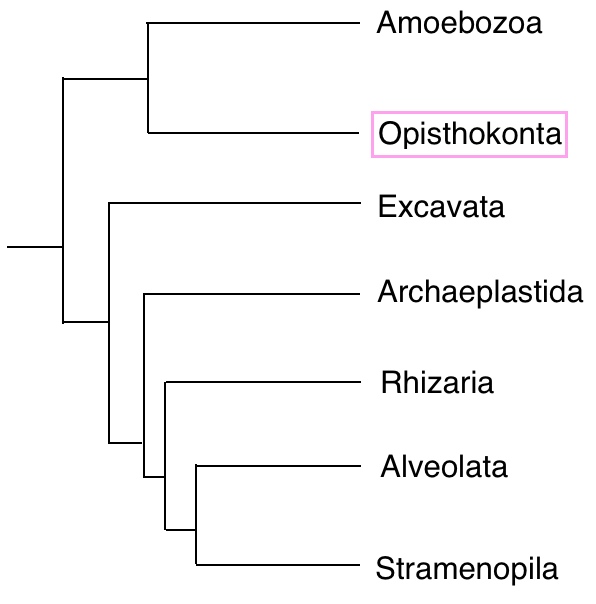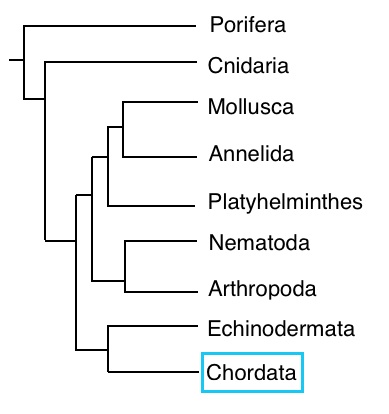Classification
Domain: Eukarya
Kingdom: Animalia
Phylum: Chordata
Class: Chondrichthyes
Order: Myliobatiformes
Family: Myliobatidae
Genus: Aetobatus
Species: Aetobus narinari
Domain: Eukarya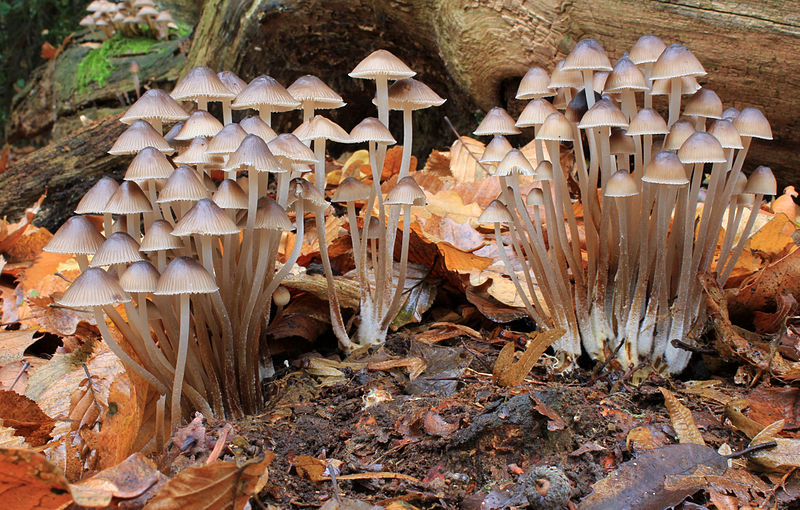
Eukarya is one of the three domains of life, and probably the
one that you are most familiar with. Organisms classified in the
domain Eukarya contain nuclei in their cells, along with other
membrane bound organelles such as mitochondria and ribosomes. This
domain contains species that have considerable variation, from
plants and animals, to diatoms and radiolarians. If you want to
learn about other eukaryotic organisms, check out these awesome pages about
watermelons and
ergot.
Figure 1. Phylogenetic tree depicting the relationships between the major clades in the eukaryotic domain. Spotted eagle rays are members of the Opisthokonta clade. This clade encompasses diverse organisms, including animals and fungi. Opisthokonts are most closely related to the Amoebozoans, which includes slime molds and lobose amoebae (Modified from Gerrish, 2014).
 Kingdom:
Animalia
Kingdom:
Animalia
Organisms, including eagle spotted rays, are classified into
the kingdom Animalia because of various unifying traits. Animals are
multicellular heterotrophs that are unable to synthesize their own
organic compounds, and need to obtain nutrients from the food they
digest. Their cells contain no cell walls and all animals, except
sponges, have true tissues, which is a group of cells performing similar
functions. Some animals that are included in this kingdom include
jellyfish, chordates, and arthropods. Interested in arthropods?
Check out this cool
dragonfly.
Phylum: Chordata
The major trait that unifies organisms in the phylum Chordata
is the presence of a notochord, which is an integral component to embryonic
development. Notochords organize the structures of a developing
embryo and also offers skeletal support. Most chordates lose their
notochord as they mature into adults, but in some groups such as
fishes, the notochord develops into a flexible rod that gives
support to the body while swimming. If you're interested in learning
about another organism in this phylum, check out this
western fence lizard.
Figure 2. Phylogenetic tree showing the relationships between the phylums found in the animal kingdom. Spotted eagles rays are classified in the phylum Chordata. They are most closely related to organisms found in the phylum Echinodermata. Organisms found in the Echinodermata and Chordata phylums are deuterostomes, triploblastic, and have bilateral symmetry, but there are also many differences. Echinoderms have spiny skin and a water vascular system, while Chordates have a notochord at some point during development (Modified from Gerrish, 2014).
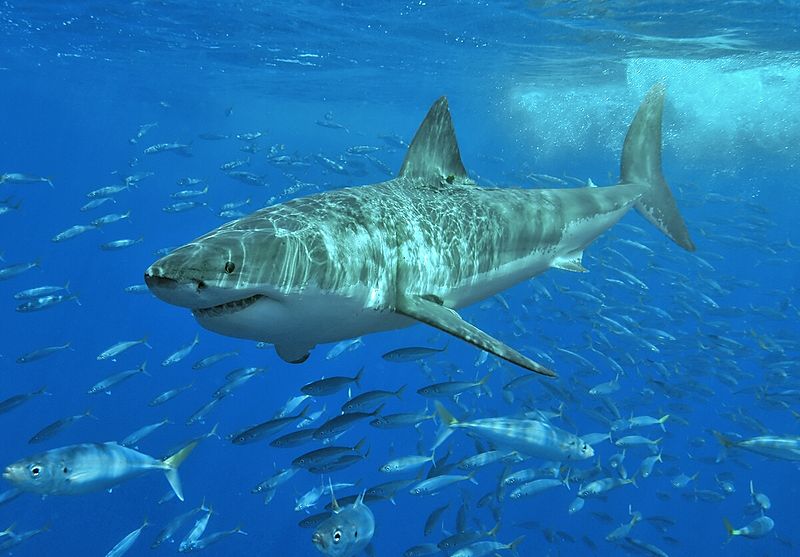 Class: Chondrichthyes
Class: Chondrichthyes
The main characteristic of the organisms classified in
the class Chondricthyes is a cartilegenous skeleton. Their
notochord, which is a defining feature of Chordates, is replaced by
cartilage as the organism ages. Teeth-like placoid scales cover
their skin, making them feel like sandpaper. There are two
subclasses: the Elasmobrachii, which includes sharks, rays, and
skates; and the Holocephali, consisting of chimaeras.

Order: Myliobatiformes
The order Myliobatiformes consists of batoid fishes (rays and
skates). Members of this order have flattened bodies called
disks, and whiplike tails that usually have poisonous spines at its
base. These batoid fishes are commonly found throughout shallow
tropical regions around the globe. They are ovoviviparous, being
born after receiving nutrients and hatching in the female's uterus.

Family: Myliobatidae
Eagle rays, cownose rays, and manta rays make up the
Myliobatidae family. They are considered the largest species of
rays, reaching lengths up to 20 feet. Similar characteristics shared
between the three different rays include having large
dorsal fins, small/absent caudal fins, and two spiracles used for
respiration located behind their eyes (Animal Diversity Web 2013).
2.jpg)
Genus: Aetobatus
The genus Aetobatus consists of eagle rays. Eagle
rays have large pectoral fins resembling wings that are used to
navigate through water, as seen in the photo to the right. They have flat teeth that aide in crushing
and grinding their
food, which consists mostly of gastropods and
bivalves. Eagle rays often stray from coasts and swim out into the
open ocean (Animal Diversity Web 2013).
Species: Aetobatus narinari
Aetobatus narinari, commonly known as spotted eagle rays, are
known for their vivid spotted dorsal colorations (seen in the photo
below). They have rounded
snouts and pointed pectoral fins. Their long tails can reach great
lengths and have two to six poisonous spines at their base (Animal
Diversity Web 2013).
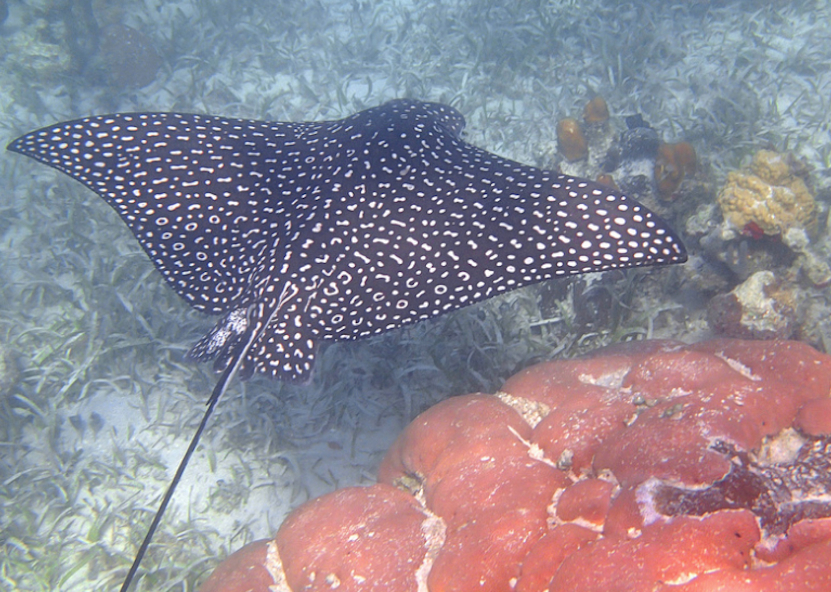 What does Aetobus narinari mean in English?
What does Aetobus narinari mean in English?
Spotted eagle rays were first described more than 200 years
ago by an 18th century scientist named Euphrasen. The original name
given to the eagle rays was Raja narinari, but was later changed to
Aetobatus narinari. In native Indian the word narinari refers to
stingrays, while the word Aetobatus is derived from two Greek words:
aetos meaning eagle, and batis meaning ray (Silliman and Gruber
1999).
Continue on to learn about Habitat and Geography, or return to the Home page.
